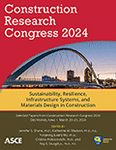Third-Party Damages to Underground Utilities: The Critical Need for Root Cause Analysis
Publication: Construction Research Congress 2024
ABSTRACT
Third-party damages to the subsurface infrastructure are a persistent issue that negatively impacts the integrity of the underground infrastructure and its vital services. Hundreds of thousands of third-party damages occur every year in the United States. These damages are more likely to reoccur when ignoring the value of learning from them. Therefore, this study investigates 16,937 damage reports that occurred in North Carolina in 2020 and were reported to North Carolina 811. The findings suggest that undesirable excavator practices contribute the most to third-party damages, followed by locator practices, general industry practices, and utility owner practices. In addition, the finding shows that most of the reported causes represent the direct causes of damages, not the root causes. Identifying the root causes is critical for a sustainable approach to significantly reducing damages to underground utilities. Overall, this study identifies the current direct causes of damages and weaknesses that hinder the industry from acquiring the needed knowledge to prevent damages to subsurface utilities.
Get full access to this article
View all available purchase options and get full access to this chapter.
REFERENCES
Al-Bayati, A. J., and Panzer, L. 2019. “Reducing Damages to Underground Utilities: Lessons Learned from Damage Data and Excavators in North Carolina.” Journal of Construction Engineering and Management. 145 (12), DOI:https://doi.org/10.1061/(ASCE)CO.1943-7862.0001724.
Al-Bayati, A. J., and Panzer, L. 2020. “Reducing Damages to Underground Utilities: Importance of Stakeholders’ Behaviors.” Journal of Construction Engineering and Management, American Society of Civil Engineers, 146(9), 04020107.
Al-Bayati, A. J., and Panzer, L. 2022. “Resilience of Infrastructure Damage Prevention: Vital Role of One Call Centers in the United States.” Practice Periodical on Structural Design and Construction, 27(2). DOI:https://doi.org/10.1061/(ASCE)SC.1943-5576.0000674.
Al-Bayati, A. J., Bilal, G. A., Esmaeili, B., Karakhan, A., and York, D. 2021. “Evaluating OSHA’s fatality and catastrophe investigation summaries: Arc flash focus.” Safety Science. 140 (105287), DOI:https://doi.org/10.1016/j.ssci.2021.105287.
Al-Bayati, A. J., Sturgill, R., Panzer, L., Victorio, S. M., and Omer, T. 2022. “Locating underground utilities in the United States: A comparative analysis of services provided by private locators.” Transportation Research Interdisciplinary Perspectives. https://doi.org/10.1016/j.trip.2022.100707.
Al-Bayati, A. J. 2021. “Infrastructure Damage Prevention Approaches in the United States.” Proc. Pipelines 2021, 102–108, American Society of Civil Engineers, Virtual Experience https://doi-org.ezproxy.ltu.edu:9443/10.1061/9780784483619.011.
Ariaratnam, S. T., and Proszek, J. J. 2004. “Legal Consequences of Damages to Underground Facilities by Horizontal Directional Drilling.” Journal of Professional Issues in Engineering Education and Practice., DOI:https://doi.org/10.1061/(ASCE)1052-3928(2006)132:4(342).
ASCE. 2002. Standard guideline for the collection and depiction of existing subsurface utility data. ASCE 38-02. Reston, VA: ASCE.
Colin, M. 2017. Incident prevention tools–incident investigations and pre-job safety analyses. Int. J. Min. Sci. Technol. 27, 635–640.
DIRT (Damage Information Reporting Tool). 2019. “DIRT Analysis and Recommendations, 2019.” Common Ground Alliance. https://commongroundalliance.com/Portals/0/Library/2020/DIRT%20Reports/2019%20DIRT%20Report%20FINAL.pdf?ver=2020-10-14-185343-180 (Accessed 4/27/2023).
DIRT (Damage Information Reporting Tool). 2020. “DIRT Analysis and Recommendations, 2020.” Common Ground Alliance. https://commongroundalliance.com/Portals/0/2020%20DIRT%20Report_09.29.2021_Final4.pdf?ver=2021-11-03-143123-490 (Accessed 4/27/2023).
Homer, J. 2023. “Power companies must adapt to climate change now. Here’s how researchers can help.” Nature, 620 (9). doi:https://doi.org/10.1038/d41586-023-02443-6.
Maree, S., Rotimi, F. E., and Rotimi, J. O. 2021. “The primacy of AS-built drawings in themanagement of Underground Utility Operations: A New Zealand study.” Buildings, 11(9),399.
Metje, M., Ahmad, B., and Crossland, S. M. 2015. “Causes, impacts and costs of strikes on buried utilities assets.” Proceedings of Institute of Civil Engineers - Municipal Engineer 168(3) 165–174.
National Transportation Safety Board. 2018. Pipeline Accident Brief: Natural Gas Explosion and Fire in Durham, North Carolina, April 10, 2019.
Nelson, C. M., Iwasaki, R. H., Arulraj, R. K., and Ayers, M. E. 2012. “SHRP 2 Tools for Underground Utility Location, Data Collection, and Analysis.” http://www.trb.org/Main/Blurbs/166876.aspx (May 13, 2023).
Pipeline and Hazardous Materials Safety Administration. 2019. Pipeline Incident 20-Year Trends.
Sturgill, R., Taylor, T., and Dadi, G. 2018. “A case study of utility co-ordination within a major design-build transportation project.” Proc., Construction Research Congress 2018, 619–628. Reston, VA: ASCE.
Underwood, P., and Waterson, P. 2014. “Systems thinking, the Swiss Cheese Model and accident analysis: A comparative systemic analysis of the Grayrigg train derailment using the ATSB, AcciMap and STAMP models.” Accid. Anal. Prev. 68, 75–94.
Zembillas, N., and Beyer, B. J. 2004. “Proactive Utilities Management: Conflict Analysis and Subsurface Utility Engineering.” Proc. Pipelines 2004, American Society of Civil Engineers, San Diego, Calif.
Information & Authors
Information
Published In
History
Published online: Mar 18, 2024
Authors
Metrics & Citations
Metrics
Citations
Download citation
If you have the appropriate software installed, you can download article citation data to the citation manager of your choice. Simply select your manager software from the list below and click Download.
